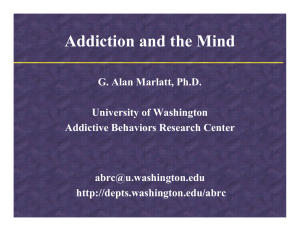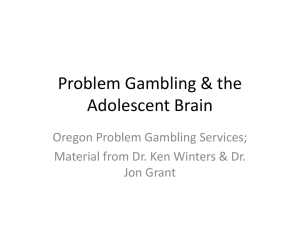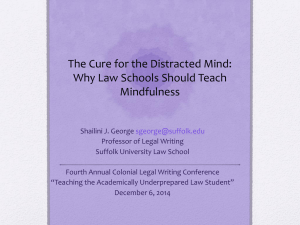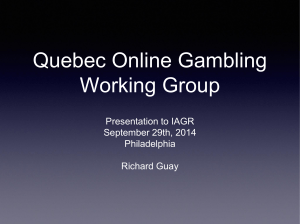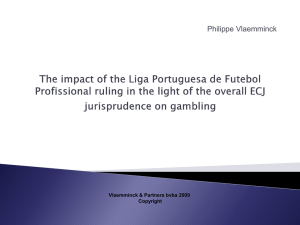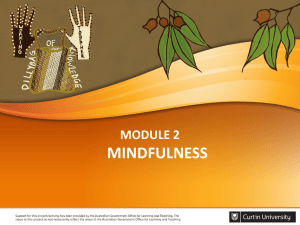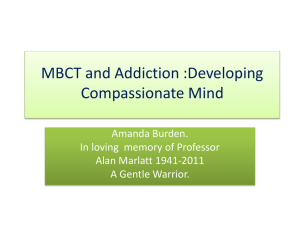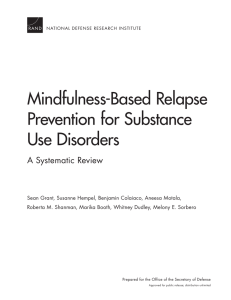Gour-EvergreenMBRP-PGpresentation
advertisement
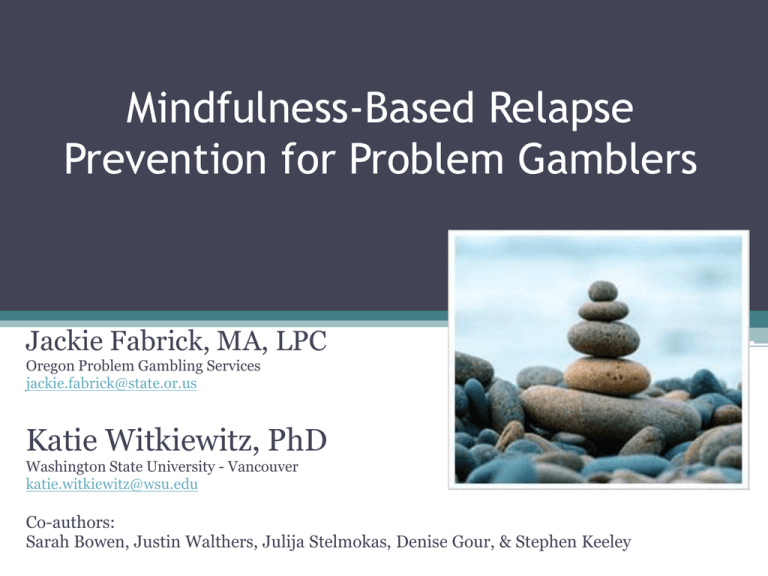
Mindfulness-Based Relapse Prevention for Problem Gamblers Jackie Fabrick, MA, LPC Oregon Problem Gambling Services jackie.fabrick@state.or.us Katie Witkiewitz, PhD Washington State University - Vancouver katie.witkiewitz@wsu.edu Co-authors: Sarah Bowen, Justin Walthers, Julija Stelmokas, Denise Gour, & Stephen Keeley Mindfulness based relapse prevention for problem gamblers – an overview. • Problem gambling is a cognitive-behavioral addiction. • Relapse prevention and mindfulness training. • Pilot study of MBRP for problem gamblers. Problem gambling has been associated with significant personal problems. Poor mental & physical health Substance abuse & suicide risk Financial & legal problems Problem gambling is a progressive addiction characterized by: ▫ ▫ ▫ ▫ ▫ increasing preoccupation with gambling a need to bet more money more frequently restlessness or irritability when attempting to stop "chasing" losses loss of control manifested by gambling behavior in spite of mounting, serious, negative consequences. Gambling in Oregon Moore, T. (2006). Oregon Gambling Addiction Treatment Foundation. Gambling in Oregon Moore, T. (2012). Oregon Health Authority, Addictions and Mental Health Division. Gambling Treatment in Oregon • Treatment is free and confidential for ▫ Problem Gamblers ▫ Family Member • FY 2010-2011 ▫ 1209 Problem Gamblers ▫ 145 Family Member Gambling Treatment in Oregon • • • • • • Outpatient treatment Residential treatment Respite care Helpline GEAR Prevention Effective treatments for problem gambling have been studied. • Gamblers Anonymous • Pharmacotherapy ▫ Opioid antagonists, antidepressants, lithium • Cognitive and cognitive behavioral therapy • Brief and motivational interventions Reviewed by Petry (2009). Cognitive and Behavioral Practice, 16, 457-467. Lapse and relapse rates for pathological gambling are high. • Psychological factors ▫ Coping skills ▫ Cognitions and affect ▫ Personality • Physiological arousal ▫ Craving and withdrawal • Social factors What is Relapse? Any gambling = Relapse • Black-and-White Model: • Cognitive-Behavioral Model: Abstinence Lapse: single instance of gambling Multiple Lapses Relapse: falling back to pretreatment levels of gambling behavior How Does Relapse Happen? The Cognitive Behavioral Model Effective Coping Response Decreased Probability of Relapse Increased Self-Efficacy High-Risk Situation Ineffective Coping Response Decreased Self-Efficacy + Positive Outcome Expectancies LAPSE Abstinence Violation Effect Increased Probability of Relapse (for initial effects of gambling) Marlatt & Gordon, 1985 Relapse Prevention is an effective treatment across disorders. ▫ ▫ ▫ ▫ ▫ ▫ ▫ Alcohol (Kadden et al., 1992; Monti et al., 2002) Cocaine (Schmitz, et al., 2001) Marijuana (Roffman, et al., 1990) Smoking (Killen, et al., 1984) Eating disorders (Mitchell & Carr, 2000) Gambling (Echeburua, et al., 2000) Sexual Offenses (Laws, 1995) (Irvin, et al., 1999; Carroll, 1996) Review of 24 Randomized Trials (Carroll, 1996) • Does not prevent a lapse, but is more effective at delaying and reducing duration and intensity of lapses • Effective at maintaining treatment effects over long term follow-up (1-2 years or more) • May be most effective for greater levels of negative affect Enhancing Relapse Prevention with Mindfulness Training What is Mindfulness? “Awareness that emerges through paying attention on purpose, in the present moment, and non-judgmentally to the unfolding of experience moment by moment” (Kabat-Zinn, 2003) MINDFULNESS EXERCISE Mindfulness Meditation? Meditation practice associated with… • increased attentional control • improved physical health and immune function • enhanced self-awareness • greater self-regulation of emotional reactions • reductions in perceived stress Mindfulness and Substance Use Paying attention: Greater awareness of triggers and responses, interrupting previously automatic behavior Nonjudgmentally: 19 In the present moment … Accepting present experience, rather than “getting a fix” to avoid the present experience Detach from attributions and “automatic” thoughts that often lead to relapse Mindfulness-Based Relapse Prevention (MBRP) MBRP Structure Integrates mindfulness with Relapse Prevention Patterned after Mindfulness-Based Stress Reduction (KabatZinn, 1990) and Mindfulness-Based Cognitive Therapy for depression (Segal et al. 2002) Outpatient Aftercare Treatment 8 weekly 2 hour sessions; daily home practice Therapists have ongoing meditation practice Components of MBRP Formal mindfulness practice Informal practice Coping strategies (Bowen, Chawla & Marlatt, 2010; Witkiewitz et al., 2005) Intentions of MBRP Awareness: From “automatic pilot” to awareness and choice Triggers: Awareness of triggers, interrupting habitual reactions Acceptance: Change relationship to discomfort, decrease need to “fix” the present moment Balance and Lifestyle: Supporting recovery and maintaining a mindfulness MBRP Session Themes Session 1: Automatic Pilot and Relapse Session 2: Awareness of Triggers and Craving Awareness, Presence Session 3: Mindfulness in Daily Life Session 4: Mindfulness in High-Risk Situations Session 5: Acceptance and Skillful Action Mindfulness and Relapse Session 6: Seeing Thoughts as Thoughts Session 7: Self-Care and Lifestyle Balance Session 8: Social Support and Continuing Practice Bigger Picture: A Balanced Life “Formal” Practices Body Scan Mindful Movement Sitting Meditation “Lovingkindness” or “metta” Mountain Meditation Walking Meditation MINDFULNESS EXERCISE Practicing Mindfulness Mind on chosen target Present Moment Observe wandering, begin again Paying Attention Attention Wanders Nonjudgmentally “If your attention wanders a hundred times, simply bring it back a hundred times.” Inquiry Pain Emotional in left knee, discomfort (depression, Restlessnessanxiety) Direct Experience (pain) “I can’t handle this. I “I can’t do this” need an escape.” Reactions, Stories, Judgment (suffering) Adapted from Segal et al., 2002 “Informal” Practices Mindfulness of daily activities Hourglass breathing space Urge surfing Hourglass Breathing Space Urge Surfing Exercise “Picture the urge as an ocean wave, and imagine yourself surfing, using your breath as the surfboard…” Bowen, Chawla & Marlatt (2010) Riding the wave, rather than giving into the urge and being wiped out by it. Staying with the urge as it grows in intensity, riding it to its peak, using the breath to stay steady as it rises and crests, knowing it will subside. Trusting that without any action on your part, all the waves of desire, like waves on the ocean, arise and eventually fade away. urge time Awareness of Triggers Situation/ Trigger An argument with my girlfriend. What sensations did you experience? Tightness in chest, sweaty palms, heart beating fast, shaky all over What What moods, thoughts feelings or arose? emotions did you notice? Anxiety, hurt, anger What did you do? “I can’t do Yelled, this.” slammed “I need a drink.” “Forget it. I don’t care anymore” door, went for a walk Relapse Cycle STOP Trigger Observe Reaction Respond w/ Awareness Initial Reaction Automatic Pilot React (e.g., lapse) Buy into (believe) thoughts Proliferating thoughts/ Reactions RELAPSE Facilitating MBRP Motivational Interviewing style Acceptance, openness, curiosity, kindness, authenticity Personal meditation practice Embodiment of these qualities Spontaneity and creativity MBRP Pilot Efficacy Trial • MBRP vs. treatment as usual control group ▫ N = 168, from community service agency ▫ 64% male, average age = 40 ▫ 52% white, 29% African American, 8% Native American ▫ 46% alcohol, 36% crack, 14% meth, 7% opiates, 19% polysubstance • Assessments at post-treatment, 2- and 4-month follow-ups NIDA R21-DA019582 (Marlatt, PI) Individuals assigned to MBRP had significantly fewer substance use days post-treatment. * Bowen et al. (2009). Substance Abuse. Individuals in MBRP reported significantly less craving over time. Time x treatment: p =.02 Time2 x treatment: p =.02 Bowen et al. (2009). Substance Abuse. Depression Scores End of Treatment No significant differences in depression scores. Moderating effect of MBRP on association between depression scores and substance use days. f 2= .18 Witkiewitz & Bowen (2010) J. Consulting & Clinical Psychology Mechanism of change? • MBRP reduces the relation between depression symptoms and substance use • Why? ▫ MBRP designed to help clients experience challenging emotions without reacting ▫ Altered the conditioned response of substance craving in response to negative affect MBRP works for substance use disorders – could it work for gambling? Mindfulness-based treatments may be effective for problem gambling. • Evidence in support of MBRP for substance use. • Case study by de Lisle, Dowling & Allen (2011): Current study – a pilot investigation of MBRP for problem gamblers. • Collaboration between MBRP and gambling treatment providers to adapt MBRP manual (Bowen et al., 2011) to be gambling specific. • Clients recruited from InAct, a gambling treatment program. Pilot Study of MBRP-PG • 8-week MBRP program ▫ Assessments at baseline, 4-weeks, and 8-weeks. • Participants (n= 11) recruited from InAct ▫ 36.4% female ▫ Average age = 53.1 (SD = 9.9), range 35-69 ▫ 8 enrolled in treatment (73%) and completed midtreatment assessment ▫ 6 completed treatment and post-treatment assessment (75%) Measures • Neuropsychological battery ▫ Shipley Institute of Living Scale • Gambling behavior ▫ National Opinion Research Center DSM-IV symptoms of pathological gambling (NODS) • Mindfulness ▫ Mindfulness Practice Questionnaire Shipley Institute of Living Scale - 2 • Brief measure of crystallized, fluid intelligence • Provides estimate of overall intelligence, as well as cognitive impairment/deterioration • Current sample: ▫ Standard score: Mean = 99.1 (SD = 17.2) ▫ Range 67 (1%) – 116 (86%) Primary Research Questions • Is MBRP effective in reducing gambling symptoms? • Does cognitive functioning predict treatment retention, mindfulness practice, and/or gambling outcomes? Results DSM-IV Symptoms of Pathological Gambling * * p < 0.05 Results Weekly mindfulness practice Results Cognitive functioning and treatment retention * * p < 0.05 Results Cognitive functioning and mindfulness practice *r = 0.78; p = 0.02 r = 0.69; p = 0.13 Results: Additional Findings • Gambling symptoms at mid- and posttreatment… ▫ No association with baseline Shipley scores. ▫ Negative, but not significant, association with mindfulness practice. Overall, promising preliminary results. Treatment retention MBRP resulted in lower gambling symptoms Cognitive Functioning Skills practice Limitations • Small sample size • No control group • Only one test of cognitive functioning • Unable to examine effects by gender, race, or age Future Directions for MBRP-PG Examine interaction between cognitive functioning and mindfulness practice in predicting gambling outcomes. Research design considerations. Compare MBRP-PG to active treatment group. Longer follow-up and more comprehensive assessment. Future Directions for MBRP Is this for everyone? Gender Dependence severity Dual diagnosis (depression, anxiety, trauma) Long term effects? Physiological and neurobiological effects Future Directions for MBRP Next steps for Oregon Grant application Training Implementation Resources • MBRP website: www.mindfulrp.com Mindfulness-Based Relapse Prevention for Addictive Behaviors: A Clinician’s Guide Guilford Press, November 2010 Acknowledgements MBRP-PG participants MBRP Facilitators Denise Gour Stephen Keeley MBRP-PG Research Team: Katie Witkiewitz Justin Walthers Sarah Bowen Julija Stelmokas MBRP Research Team: Alan Marlatt, PhD Sarah Bowen, PhD Katie Witkiewitz, PhD Treatment Providers Oregon Problem Gambling InAct – Oregon VOA Recovery Centers of King County Neha Chawla, PhD Seema Clifasefi, PhD Susan Collins, PhD Joel Grow, MS Brian Ostafin, PhD Mary Larimer, PhD Kathy Lustyk, PhD Thank you!
